Plectranthus scutellarioides
| Plectranthus scutellarioides | |
|---|---|
| Naturalized in Puerto Rico | |
| Scientific classification | |
| Kingdom: | Plantae |
| Clade: | Angiosperms |
| Clade: | Eudicots |
| Clade: | Asterids |
| Order: | Lamiales |
| Family: | Lamiaceae |
| Genus: | Plectranthus |
| Species: | P. scutellarioides |
| Binomial name | |
| Plectranthus scutellarioides | |
| Synonyms[1] | |
| |
Plectranthus scutellarioides, commonly known as coleus, is a species of flowering plant in the family Lamiaceae (the mint or deadnettle family), native to southeast Asia through to Australia. Typically growing to 60–75 cm (24–30 in) tall and wide, it is a bushy, woody-based evergreen perennial, widely grown for the highly decorative variegated leaves found in cultivated varieties.[2] Another common name is painted nettle,[3] reflecting its relationship to deadnettles (Lamium species), which are in the same family. (True nettles and their close kin are in the family Urticaceae.) The synonyms Coleus blumei and Solenostemon scutellarioides are also widely used names for this species.
Description
Plectanthrus scutellarioides is an upright annual or short-lived perennial plant. It may be as much as 1 m (3 ft) tall, with well branched, more-or-less four-sided stems.[4] Shorter, more trailing forms have sometimes been described as separate species, under names such as Coleus pumilus[4] or Solenostemon pumilus,[5] but are all now considered part of the very variable P. scutellarioides.[4] The species is extremely variable in the colour and shape of the leaves. They are somewhat fleshy, varying in size from 1.5–10 cm (0.6–3.9 in) long by 1–6 cm (0.4–2.4 in) wide, generally ovate in shape, and borne on petioles (stalks) from 0.5–5 cm (0.2–2.0 in) long. The leaf margin is divided to a variable degree. Hairs are present on both sides of the leaf.[4]
The inflorescence is borne on the end of a stem and, like the leaves, is very variable in size; it may be up to 4 cm (1.6 in) long, with few or many flowers. The calyx is bell-shaped, initially only 1–2 mm (0.04–0.08 in) long, but lengthening to 5–7 mm (0.2–0.3 in) when in fruit. The bluish-purple petals are joined to form a typical two-lipped labiate flower, 8–10 mm (0.3–0.4 in) long. The stamens are joined for about half their length and are covered by the upper lip of the flower. The fruit is described as a "nutlet", and is black, about 1 mm (0.04 in) long.[4]
The leaves of the wild species may be somewhat variegated,[4] but this has been developed to an extreme degree in cultivated varieties, whose leaves may include one or more shades of green, white, cream, yellow, pink, red, maroon and dark purple.
Taxonomy
The species was first described by Carl Linnaeus in 1763, as Ocimum scutellarioides. The genus Ocimum is best known for Ocimum basilicum, sweet basil. The specific epithet scutellarioides means "resembling the genus Scutellaria" – a genus also in the Lamiaceae, whose name is derived from the Latin scutella, meaning a small dish or bowl.[6]
Genera and species related to Ocimum, placed in the tribe Ocimeae, have been the subject of considerable taxonomic confusion,[7] and P. scutellarioides has been placed in several genera and been given multiple synonyms. Robert Brown transferred O. scutellarioides to the genus Plectranthus in 1810. George Bentham transferred it to the genus Coleus as Coleus scutellarioides in 1830, and in 1832 also described Coleus blumei, now regarded as just a variant of this species. It was transferred to Solenostemon by Leslie E. W. Codd in 1975.[4]
Placement in the genus Coleus, and the name Coleus blumei, led to the name "coleus", still widely used by horticulturalists and gardeners, and now treated as a common name for this species. The synonym Solenostemon scutellarioides is also widely used.
Within Plectranthus, molecular phylogenetic studies suggest that P. scutellarioides is most closely related to Plectranthus fredericii and some other species that are purely African in distribution.[7]
Distribution and habitat
Plectranthus scutellarioides is native to India (including the Himalayas), Sri Lanka, China, Burma, Thailand, Laos, Vietnam, Malaysia, Indonesia and Australia. It is cultivated worldwide and sometimes naturalized in other tropical regions. In its native habitat, it is found at elevations of 100–1,600 m (330–5,250 ft), where it flowers and fruits throughout the year.[4]
Cultivation
History
The species was first introduced into Europe from Java in 1851 by a Dutch horticulturalist. At this time, there were few leaf colors and shapes. A wider variety was available by 1877, when the American William Bull offered seeds at 43 US cents each. However, by selecting for seed production, early flowering was inadvertently favored, and leaf color also declined in intensity. Coleus breeding revived in the early 1940s, and by the 1980s, the availability of an improved range of cultivars led to coleus becoming the tenth most important bedding crop in the US. More recently, vegetative propagation has enabled cultivars with novel leaf colors and shapes to be offered for sale. Plants with trailing as well as upright habits are now available.[8]
Cultivars
- Variation in leaf color and shape in cultivars
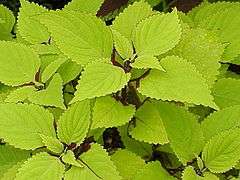
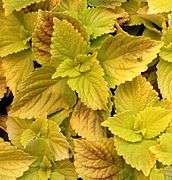

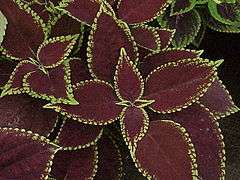
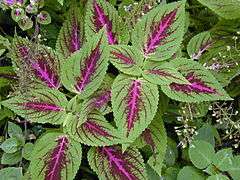

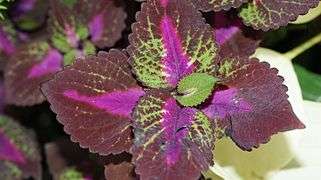
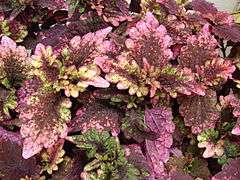
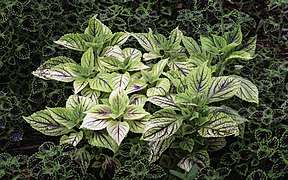
.jpg)
The leaves of cultivars typically show sharp contrasts between their colors; particular leaves may be several shades of green, pink, yellow, "black" (a very dark purple), maroon, cream, white, and red (somewhat resembling the unrelated Caladium). The leaf shape also varies from broadly ovate to more narrowly lanceolate. The leaf margins may have small or large teeth or be wavy, as may the whole leaf. New cultivars with different leaf shapes and color combinations are constantly being created. The following cultivars have gained the Royal Horticultural Society's Award of Garden Merit:
Green coloration is due to the amount of chlorophyll present in the chloroplasts in the leaves. Red, purple, pink, and orange colors are due to anthocyanins – water-soluble, flavonoid biosynthetic pigments, found in the foliage in addition to chlorophyll. The increase in anthocyanin production is accompanied by a decrease in chlorophyll production. The production of anthocyanins and chlorophyll is affected by light levels; the more light is present, the more anthocyanins are produced, with an inverse relationship to the production of chlorophyll. Anthocyanins are created inside the cell and facilitate photosynthesis in leaves that are exposed to very intense or prolonged sunlight by providing protection from damage caused by ultraviolet light. Some coleus cultivars over-produce anthocyanins and under-produce chlorophyll to the extent that optimal growth is prevented.[17]
Care
In cultivation, plants grow well in moist well-drained soil, and are usually 0.5–1 m (1.6–3.3 ft) tall, though some may grow as tall as 2 m (6.6 ft). Coleus are grown as ornamental plants. They are heat-tolerant, but they do less well in full sun in subtropical areas than in the shade. In areas without freezing temperatures, plants can usually be kept as perennials if well managed. In colder areas, they are often grown as annuals, since the plants are not hardy and become leggy with age. In bright, hot areas, the colors of the plant are typically more intense in shade than in full sun, and the plants require less water there. Coleus also make low-maintenance houseplants, and can often be propagated by clipping a piece of stem just below the leaves and putting the stem in water to root. Young inflorescences may be removed to keep plants more compact.[18]
Propagation
There are two ways to propagate coleus. Seeds are inexpensive and easily obtainable, though named cultivars do not come true from seeds. To germinate seeds, simply sprinkle seeds on the soil surface and press down. Seeds require light to germinate, so should not be covered. They may be kept moist by growing in a container covered with plastic, or by misting seeds daily. Sprouts can show color in as little as two weeks. Alternatively, cuttings can be taken. Cuttings root readily in plain water, without the addition of rooting hormone (although it is still beneficial).
Diseases
The downy mildew Peronospora sp. makes leaves brownish and can also cause leaf curling and twisting. It is harder to control this mildew on stems compared to leaves.[19] Another disease is impatiens necrotic spot virus which causes brown or yellow spots on leaves, rings, black or brown stem discoloration, and brown leaf veins, ultimately resulting in plant death. The disease is spread by an insect called a thrips that carries the virus from an infected plant to an uninfected one. It only takes a few of these insects to infect a whole greenhouse.[20]
Psychoactivity
Plectranthus scutellarioides, under the name Coleus blumei, has been reported to have very mild relaxing and/or hallucinogenic effects when consumed. The effects of the plant have not been scientifically explored in great detail, but the plant is known to have been used by the Mazatec Indians of southern Mexico for its mind-altering effects.[21]
Gallery
- Inflorescence
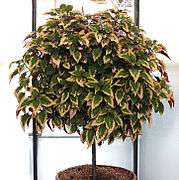 Cultivar grown as a short standard
Cultivar grown as a short standard
| Wikimedia Commons has media related to Solenostemon scutellarioides. |
References
- ↑ "The Plant List: A Working List of All Plant Species". Retrieved June 19, 2014.
- ↑ RHS A-Z encyclopedia of garden plants. United Kingdom: Dorling Kindersley. 2008. p. 1136. ISBN 1405332964.
- ↑ "Plectranthus scutellarioides". Germplasm Resources Information Network (GRIN). Agricultural Research Service (ARS), United States Department of Agriculture (USDA). Retrieved 2017-02-15.
- 1 2 3 4 5 6 7 8 Suddee, S.; Paton, A.J. & Parnell, J.A.N. (2004). "A Taxonomic Revision of Tribe Ocimeae Dumort. (Lamiaceae) in Continental South East Asia II. Plectranthinae". Kew Bulletin. 59 (3): 379–414. doi:10.2307/4110950. JSTOR 4110950.
- ↑ Nguyen, P.; Quesenberry, K. & Clark, D. (2008). "Genetics of Growth Habit and Development of New Coleus (Solenostemon) Varieties with Trailing Habit and Bright Color". Journal of Heredity. 99 (6): 573–580. doi:10.1093/jhered/esn054. PMID 18603655.
- ↑ Hyam, R. & Pankhurst, R.J. (1995). Plants and their names : a concise dictionary. Oxford: Oxford University Press. ISBN 978-0-19-866189-4.
- 1 2 Paton, Alan J; Springate, David; Suddee, Somran; Otieno, Donald; Grayer, Renée J; Harley, Madeline M; Willis, Fiona; Simmonds, Monique S. J; Powell, Martyn P & Savolainen, Vincent (2004). "Phylogeny and evolution of basils and allies (Ocimeae, Labiatae) based on three plastid DNA regions". Molecular Phylogenetics and Evolution. 31 (1): 277–299. doi:10.1016/j.ympev.2003.08.002. Retrieved 2017-02-13.
- ↑ Nguyen, Phuong Ngoc (2007). Genetic, Molecular and Breeding Study of Coleus (Solenostemon scutellarioides (L.) Codd) during Growth and Development (PDF) (PhD thesis). University of Florida. Retrieved 2017-02-16.
- ↑ "RHS Plant Selector - Solenostemon scutellarioides 'Crimson Ruffles'". Retrieved 4 July 2013.
- ↑ "RHS Plant Selector - Solenostemon scutellarioides 'Lord Falmouth'". Retrieved 4 July 2013.
- ↑ "RHS Plant Selector - Solenostemon scutellarioides 'Picturatus'". Retrieved 4 July 2013.
- ↑ "RHS Plant Selector - Solenostemon scutellarioides 'Pineapple Beauty'". Retrieved 4 July 2013.
- ↑ "RHS Plant Selector - Solenostemon scutellarioides 'Pineapplette'". Retrieved 4 July 2013.
- ↑ "RHS Plant Selector - Solenostemon scutellarioides 'Royal Scot'". Retrieved 4 July 2013.
- ↑ "RHS Plant Selector - Solenostemon scutellarioides 'Walter Turner'". Retrieved 4 July 2013.
- ↑ "RHS Plant Selector - Solenostemon scutellarioides 'Wisley Tapestry'". Retrieved 4 July 2013.
- ↑ Nguyen, P. & Dal Cin, V. (2009), "The role of light on foliage colour development in coleus (Solenostemon scutellarioides (L.) Codd)", Plant Physiology and Biochemistry, 47: 934–945, doi:10.1016/j.plaphy.2009.06.006, PMID 19631554
- ↑ "Indoor Coleus Care: How To Grow A Coleus Houseplant". Retrieved 2017-05-09.
- ↑ Archived October 9, 2011, at the Wayback Machine.
- ↑ Plant Disease Diagnostic Clinic University of Wisconsin-Madison and UW-Extension
- ↑ Schultes, Richard Evans (1976). Hallucinogenic Plants. Golden Guides. Illustrated by Elmer W. Smith. New York: Golden Press. p. 138. ISBN 978-0-307-24362-1. OCLC 2761333. Retrieved 2011-07-22.